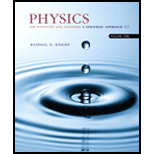
l. Can an insulator be charged? If so, how would you charge an
insulator? If not, why not?
Whether the insulator can be charged or not and the method used to charge an insulator.
Answer to Problem 1CQ
Solution: Yes, by friction method
Explanation of Solution
Insulator is a material where the material won’t conduct electricity. They are tightly bound to the nuclei as there are no free electrons in it. This is the reason that the material does not conduct electricity.
The method used to charge the insulator is the friction method, when two insulators are rubbed to each other, the electrons move from one material to another. The material that losses the electron will lead to positively charged material, and the material that gains the electron will lead to negatively charged material.
Conclusion:
Yes, it is possible to charge an insulator, the method used to charge an insulator is friction method.
Want to see more full solutions like this?
Chapter 22 Solutions
Physics for Scientists and Engineers: A Strategic Approach, Vol. 1 (Chs 1-21) (4th Edition)
Additional Science Textbook Solutions
Physics: Principles with Applications
Lecture- Tutorials for Introductory Astronomy
Conceptual Physics: The High School Physics Program
College Physics: A Strategic Approach (3rd Edition)
Essential University Physics: Volume 2 (3rd Edition)
- An amoeba has 1.001016protons and a net charge of 0.300 pC. (a) How many fewer electrons are there than protons? (b) If you paired them up, what fraction of the protons would have no electrons?arrow_forward(a) Would life be different if the electron were positively charged and the proton were negatively charged? (b) Does the choice of signs have any bearing on physical and chemical interactions? Explain your answers.arrow_forwardA person is placed in a large, hollow, metallic sphere that is insulated from ground, (a) If a large charge is placed on the sphere, will the person be harmed upon touching the inside of the sphere? (b) Explain what will happen if the person also has an initial charge whose sign is opposite that of the charge on the sphere.arrow_forward
- (a) How strong is the attractive force between a glass rod with a 0.700 C charge and a silk cloth with a 0.600 C charge, which are 12.0 cm apart, using the approximation that they act like point charges? (b) Discuss how the answer to this problem might be affected if the charges are distributed over some area and do not act like point charges.arrow_forward(a) What is the direction and magnitude of an electric field that supports the weight of a free electron near the surface of Earth? (b) Discuss what the small value for this field implies regarding the relative strength of the gravitational and electrostatic forces.arrow_forwardA 2.5-g copper penny is given a charge of 4.0109C . (a) How many electrons ale removed from the penny? (b) If no more than one electron is removed from an atom, what percent of the atoms are ionized by this charging process?arrow_forward
- Unreasonable results A wrecking yard inventor wants to pick up cars by charging a 0.400 m diameter ball and inducing an equal and opposite charge on the car. If a car has a 1000 kg mass and the ball is to be able to lift it from a distance of 1.00 m: (a) What minimum charge must be used? (b) What is the electric field near the surface of the ball? (c) Why are these results unreasonable? (d) Which premise or assumption is responsible?arrow_forward(a) What magnitude point charge creates a 10,000 N/C electric field at a distance of 0.250 m? (b) How large is the field at 10.0 m?arrow_forwardA balloon clings to a wall after it is negatively charged by rubbing. (a) Does that occur because the wall is positively charged? (b) Why does the balloon eventually fall?arrow_forward
- Two small, identical metal balls with charges 5.0 C and 15.0 C are held in place 1.0 m apart. In an experiment, they are connected for a short time by a conducting wire. a. What will be the charge on each ball after this experiment? b. By what factor will the magnitude of the electrostatic force on either ball change after this experiment is performed?arrow_forward(a) Find the total electric field at x = 1.00 cm in Figure 18.52(b) given that q =5.00 nC. (b) Find the total electric field at x = 11.00 cm in Figure 18.52(b). (c) If the charges are allowed to move and eventually be brought to rest by friction, what will the final charge configuration be? (That is, will there be a single charge, double charge; etc., and what will its value(s) he?)arrow_forwardEach of the following statements is related to conductors in electrostatic equilibrium. Choose the words that make each statement correct. (i) The net charge is always zero [(a) inside; (b) on] the surface of an isolated conductor. (ii) The electric field is always zero [(c) inside; (d) just outside] a perfect conductor. (iii) The charge density on the surface of an isolated, charged conductor is highest where the surface is [(e) sharpest; (f) smoothest].arrow_forward
 Physics for Scientists and Engineers, Technology ...PhysicsISBN:9781305116399Author:Raymond A. Serway, John W. JewettPublisher:Cengage Learning
Physics for Scientists and Engineers, Technology ...PhysicsISBN:9781305116399Author:Raymond A. Serway, John W. JewettPublisher:Cengage Learning College PhysicsPhysicsISBN:9781938168000Author:Paul Peter Urone, Roger HinrichsPublisher:OpenStax College
College PhysicsPhysicsISBN:9781938168000Author:Paul Peter Urone, Roger HinrichsPublisher:OpenStax College Principles of Physics: A Calculus-Based TextPhysicsISBN:9781133104261Author:Raymond A. Serway, John W. JewettPublisher:Cengage Learning
Principles of Physics: A Calculus-Based TextPhysicsISBN:9781133104261Author:Raymond A. Serway, John W. JewettPublisher:Cengage Learning
 Physics for Scientists and Engineers: Foundations...PhysicsISBN:9781133939146Author:Katz, Debora M.Publisher:Cengage Learning
Physics for Scientists and Engineers: Foundations...PhysicsISBN:9781133939146Author:Katz, Debora M.Publisher:Cengage Learning College PhysicsPhysicsISBN:9781285737027Author:Raymond A. Serway, Chris VuillePublisher:Cengage Learning
College PhysicsPhysicsISBN:9781285737027Author:Raymond A. Serway, Chris VuillePublisher:Cengage Learning





